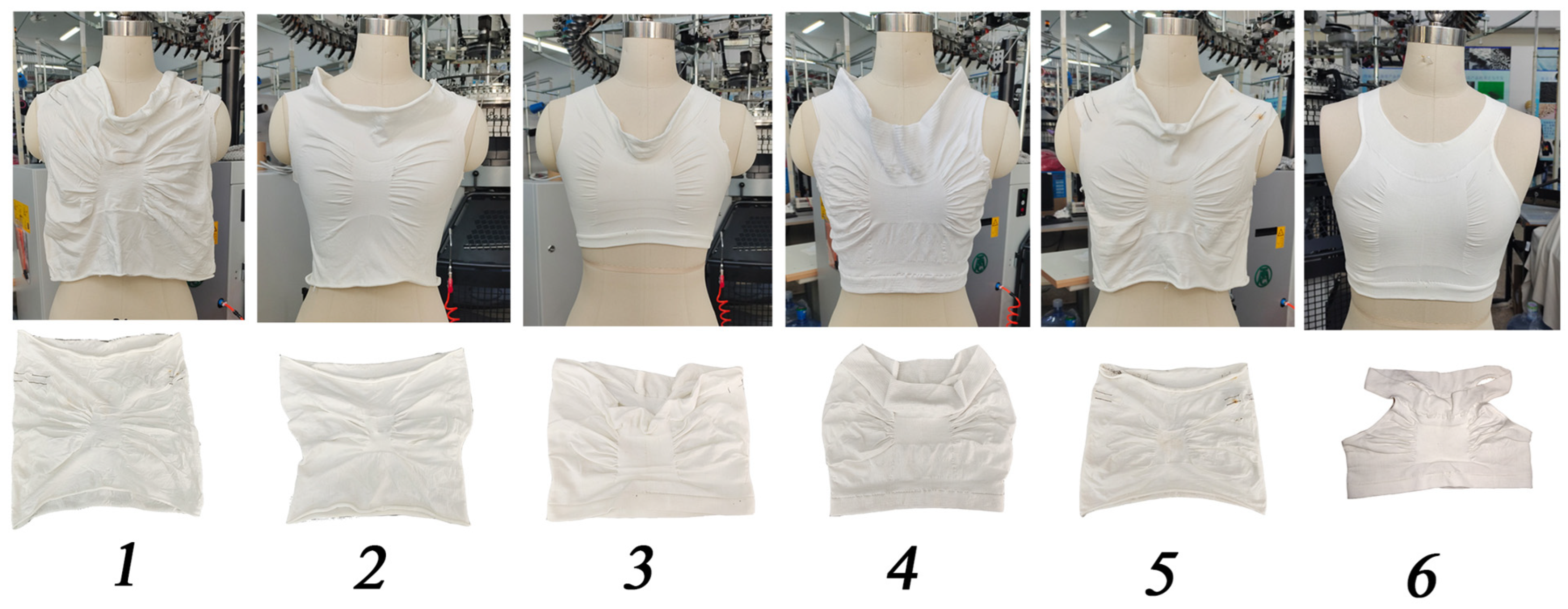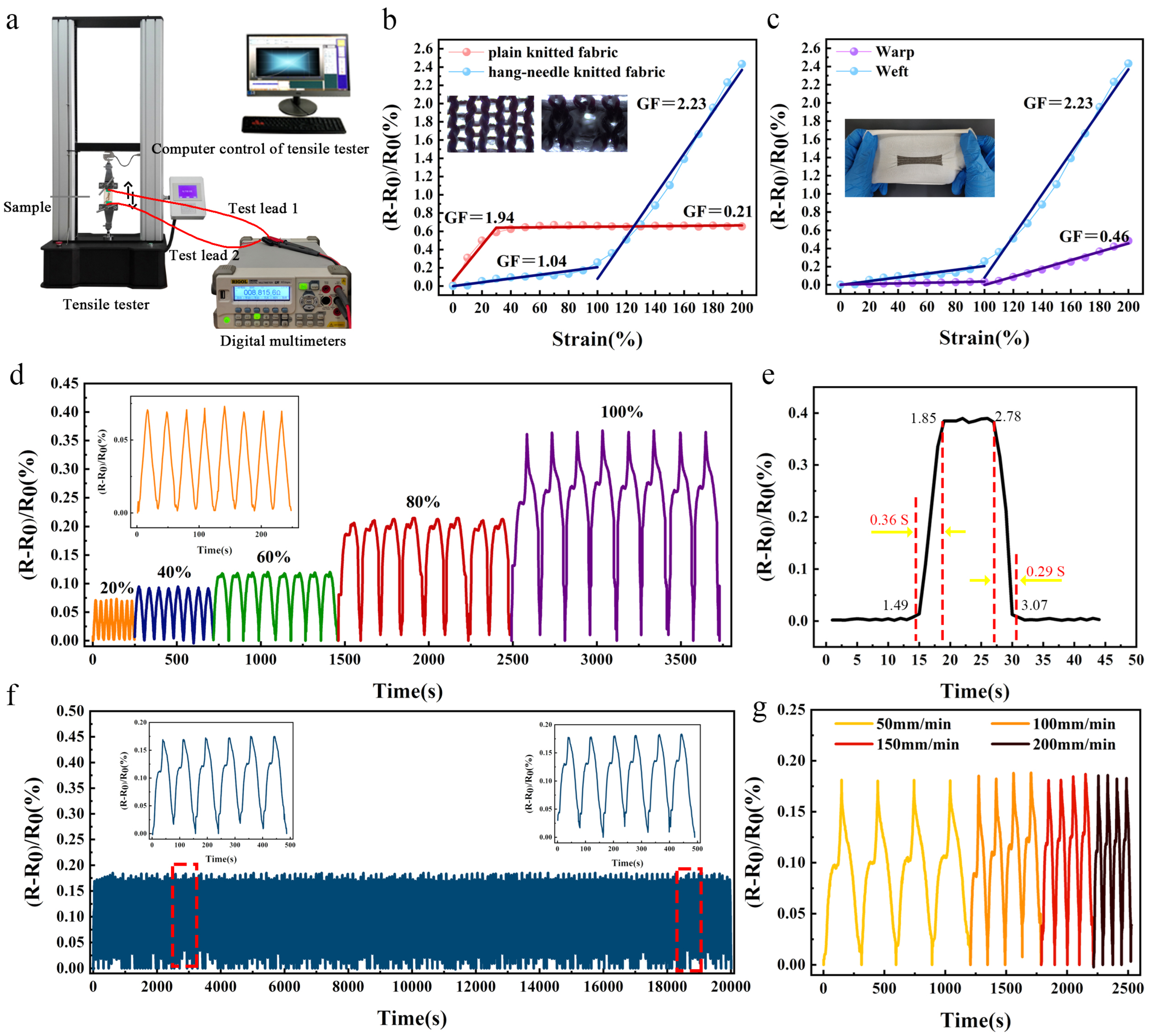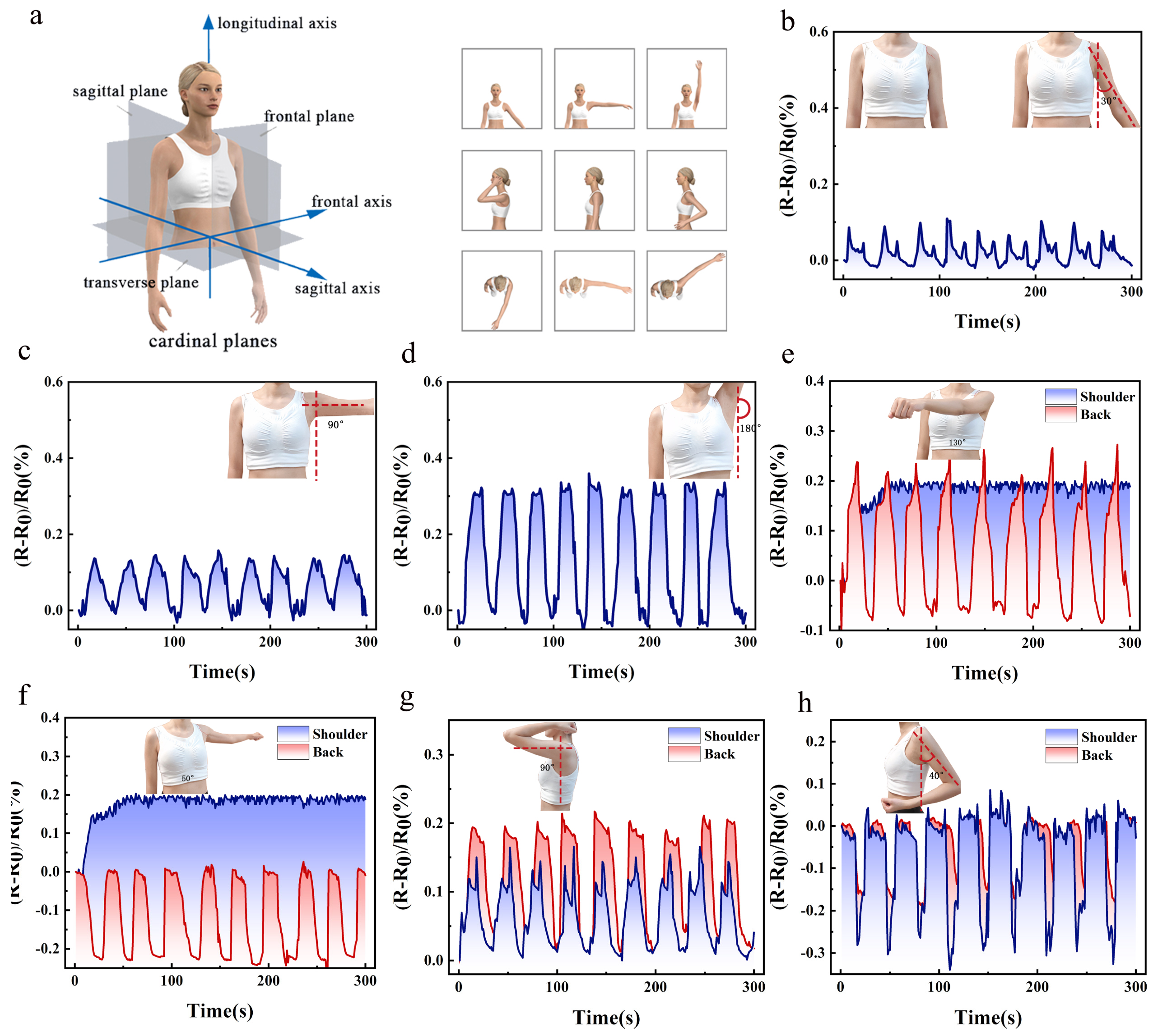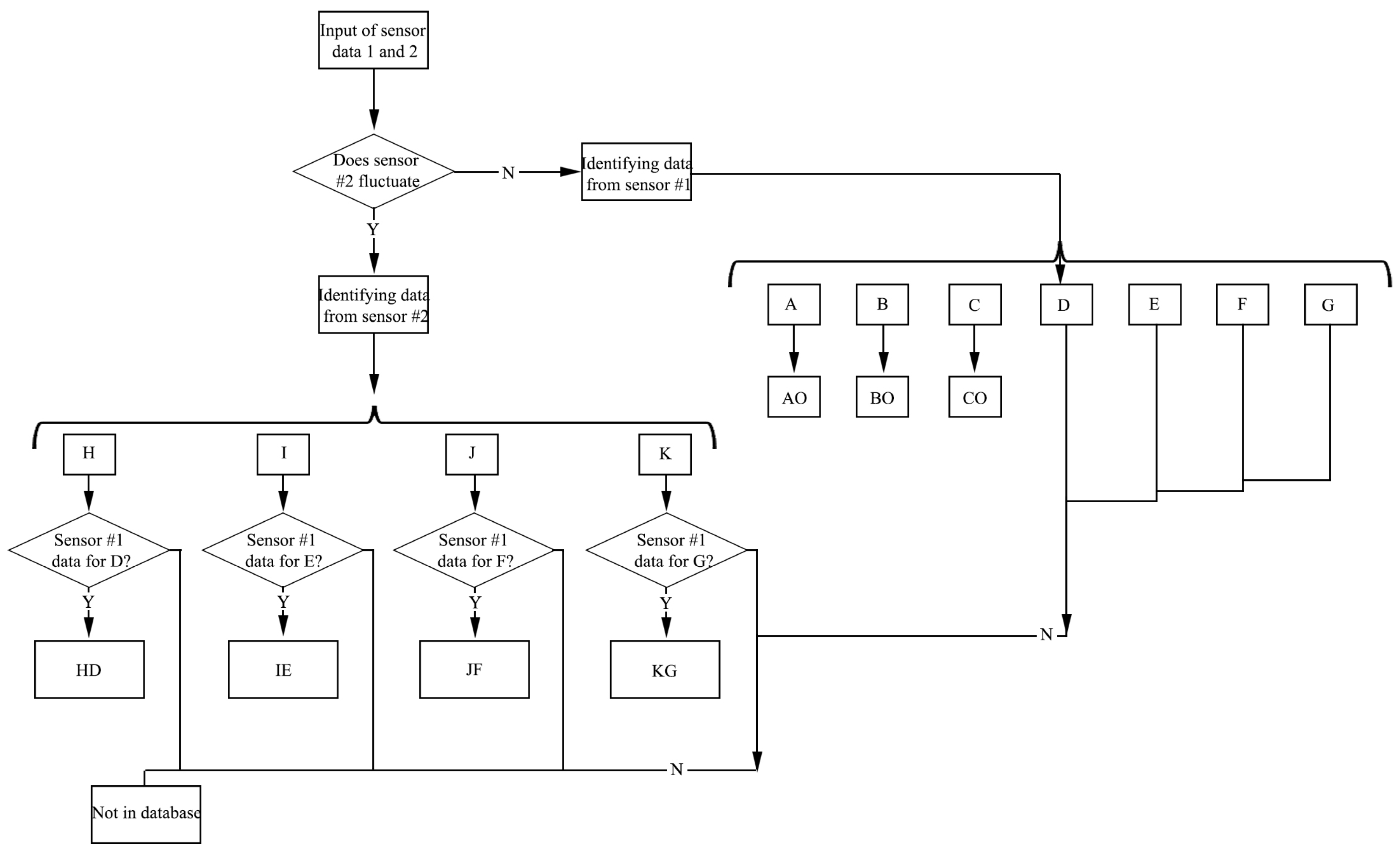Seamless Weft Knit Vest with Integrated Needle Sensing Zone for Monitoring Shoulder Movement: A First Methodological Study
Abstract
1. Introduction
2. Preparation of Experimental Materials
2.1. Knit of One-Piece Seamless Knitted Vest
2.2. Knit of Embedded Hanger Sensing Zone
2.3. The Seamless Knitted of EHSZ and OKSV
3. Test Results and Analysis of EHSZ
3.1. Sensing Performance of the EHSZ
3.2. Structure and Working Mechanism of EHSZ
4. Real-time Monitoring of Human Respiration
5. Conclusions
6. Limitations and Future Direction
Author Contributions
Funding
Institutional Review Board Statement
Informed Consent Statement
Data Availability Statement
Conflicts of Interest
References
- Liu, Z.; Zhu, T.; Wang, J.; Zheng, Z.; Li, Y.; Li, J.; Lai, Y. Functionalized Fiber-Based Strain Sensors: Pathway to Next-Generation Wearable Electronics. Nano-Micro Lett. 2022, 14, 61. [Google Scholar]
- Zhou, L.; Shen, W.; Liu, Y.; Zhang, Y. A Scalable Durable and Seamlessly Integrated Knitted Fabric Strain Sensor for Human Motion Tracking. Adv. Mater. Technol. 2022, 7, 2200082. [Google Scholar] [CrossRef]
- Wang, J.; Lu, C.; Zhang, K. Textile-Based Strain Sensor for Human Motion Detection. Energy Environ. Mater. 2019, 3, 80–100. [Google Scholar] [CrossRef]
- al Rumon, A.; Cay, G.; Ravichandran, V.; Altekreeti, A.; Gitelson-Kahn, A.; Constant, N.; Solanki, D.; Mankodiya, K. Textile Knitted Stretch Sensors for Wearable Health Monitoring: Design and Performance Evaluation. Biosensors 2023, 13, 34. [Google Scholar]
- Zhang, H.; Zhang, D.; Guan, J.; Wang, D.; Tang, M.; Ma, Y.; Xia, H. A flexible wearable strain sensor for human-motion detection and a human–machine interface. J. Mater. Chem. C 2022, 10, 15554–15564. [Google Scholar] [CrossRef]
- Zhang, X.; Ke, L.; Zhang, X.; Xu, F.; Hu, Y.; Lin, H.; Zhu, J. Breathable and Wearable Strain Sensors Based on Synergistic Conductive Carbon Nanotubes/Cotton Fabrics for Multi-directional Motion Detection. ACS Appl. Mater. Interfaces 2022, 14, 25753–25762. [Google Scholar] [CrossRef]
- Ye, X.; He, Y.; Li, S.; Hu, H.; Gan, L.; Huang, J. Auxetic Wearable Sensors Based on Flexible Triboelectric Polymers for Movement Monitoring. ACS Appl. Polym. Mater. 2022, 4, 4339–4346. [Google Scholar] [CrossRef]
- Zhou, X.; Hu, C.; Lin, X.; Han, X.; Zhao, X.; Hong, J. Polyaniline-coated cotton knitted fabric for body motion monitoring. Sensors Actuators A Phys. 2021, 321, 112591. [Google Scholar] [CrossRef]
- Isaia, C.; McMaster, S.A.; McNally, D. Study of performance of knitted conductive sleeves as wearable textile strain sensors for joint motion tracking. In Proceedings of the 2020 42nd Annual International Conference of the IEEE Engineering in Medicine & Biology Society (EMBC), Montreal, QC, Canada, 20–24 July 2020; pp. 4555–4558. [Google Scholar]
- Lu, D.; Liao, S.; Chu, Y.; Cai, Y.; Wei, Q.; Chen, K.; Wang, Q. Highly Durable and Fast Response Fabric Strain Sensor for Movement Monitoring Under Extreme Conditions. Adv. Fiber Mater. 2022, 5, 223–234. [Google Scholar]
- Park, S.; Choi, H.; Cho, Y.; Jeong, J.; Sun, J.; Cha, S.; Choi, M.; Bae, J.; Park, J.-J. Wearable Strain Sensors with Aligned Macro Carbon Cracks Using a Two-Dimensional Triaxial-Braided Fabric Structure for Monitoring Human Health. ACS Appl. Mater. Interfaces 2021, 13, 22926–22934. [Google Scholar] [CrossRef]
- Wang, G.; Liu, Y.; Xu, F.; Liu, G.; Qiu, J. Design and optimization of isotropic stretchable strain sensors for multidirectional monitoring. Smart Mater. Struct. 2021, 31, 015009. [Google Scholar]
- Steijlen, A.; Burgers, B.; Wilmes, E.; Bastemeijer, J.; Bastiaansen, B.; French, P.; Bossche, A.; Jansen, K. Smart sensor tights: Movement tracking of the lower limbs in football. Wearable Technol. 2021, 2, e17. [Google Scholar]
- Seyedin, S.; Uzun, S.; Levitt, A.; Anasori, B.; Dion, G.; Gogotsi, Y.; Razal, J.M. MXene Composite and Coaxial Fibers with High Stretchability and Conductivity for Wearable Strain Sensing Textiles. Adv. Funct. Mater. 2020, 30, 1910504. [Google Scholar] [CrossRef]
- Dou, L.; Zeng, Z.; Cheng, D.; Li, S.; Ke, W.; Cai, G. Weft-Knitted Spacer Fabric for Highly Stretchable-Compressible Strain Sensor, Supercapacitor, and Joule Heater. Nanomaterials 2022, 12, 3684. [Google Scholar] [CrossRef]
- Zhang, Q.; Yun, G.; Zhao, B.; Lu, H.; Zhang, S.; Tang, S.-Y.; Li, W. Highly stretchable and sensitive strain sensor based on liquid metal composite for wearable sign language communication device. Smart Mater. Struct. 2021, 30, 115005. [Google Scholar]
- Zhao, B.; Cong, H.; Dong, Z. Highly stretchable and sensitive strain sensor based on Ti3C2-coated electrospinning TPU film for human motion detection. Smart Mater. Struct. 2021, 30, 095003. [Google Scholar]
- Wang, X.; Li, Q.; Tao, X. Enhanced electromechanical resilience and mechanism of the composites-coated fabric sensors with crack-induced conductive network for wearable applications. Smart Mater. Struct. 2022, 31, 035032. [Google Scholar]
- Zhang, C.; Xue, P.; Luo, Y. Flexible polypyrrole-coated conductive fabric sensor for large deformation measurement. Int. J. Cloth. Sci. Technol. 2019, 31, 609–618. [Google Scholar] [CrossRef]
- Yang, Q.; Liu, N.; Yin, J.; Tian, H.; Yang, Y.; Ren, T.-L. Understanding the Origin of Tensile Response in a Graphene Textile Strain Sensor with Negative Differential Resistance. ACS Nano 2022, 16, 14230–14238. [Google Scholar] [CrossRef]
- Atalay, O. Textile-Based, Interdigital, Capacitive, Soft-Strain Sensor for Wearable Applications. Materials 2018, 11, 768. [Google Scholar] [CrossRef]
- Gurarslan, A.; Özdemir, B.; Bayat, İ.H.; Yelten, M.B.; Karabulut Kurt, G. Silver nanowire coated knitted wool fabrics for wearable electronic applications. J. Eng. Fibers Fabr. 2019, 14, 1558925019856222. [Google Scholar]
- Shen, X.; Zhao, S.; Wan, A. A sensitive and flexible sensor enhanced by constructing graphene-based polyaniline conductive networks. Sens. Actuators A Phys. 2021, 330, 112862. [Google Scholar] [CrossRef]
- He, X.; Shen, G.; Liang, J.; Liu, Z.; Xin, Y.; Liang, T.; He, J.; Zhang, C.; Chen, Y.; He, X. Stretchable Strain Sensors Based on Two- and Three-Dimensional Carbonized Cotton Fabrics for the Detection of Full Range of Human Motions. ACS Appl. Electron. Mater. 2021, 3, 3287–3295. [Google Scholar] [CrossRef]
- Wu, Y.; Zhou, S.; Yi, J.; Wang, D.; Wu, W. Facile fabrication of flexible alginate/polyaniline/graphene hydrogel fibers for strain sensor. J. Eng. Fibers Fabr. 2022, 17, 15589250221114641. [Google Scholar]
- Sadi, S.; Yang, M.; Luo, L.; Cheng, D.; Cai, G.; Wang, X. Direct screen printing of single-faced conductive cotton fabrics for strain sensing, electrical heating and color changing. Cellulose 2019, 26, 6179–6188. [Google Scholar] [CrossRef]
- Liang, X.; Cong, H.; Dong, Z.; Jiang, G. Size Prediction and Electrical Performance of Knitted Strain Sensors. Polymers 2022, 14, 2354. [Google Scholar] [CrossRef]
- Jiang, Y.; An, J.; Liang, F.; Zuo, G.; Yi, J.; Ning, C.; Zhang, H.; Dong, K.; Wang, Z.L. Knitted self-powered sensing textiles for machine learning-assisted sitting posture monitoring and correction. Nano Res. 2022, 15, 8389–8397. [Google Scholar]
- Fink, P.L.; Sayem, A.S.M.; Teay, S.H.; Ahmad, F.; Shahariar, H.; Albarbar, A. Development and wearer trial of ECG-garment with textile-based dry electrodes. Sens. Actuators A Phys. 2021, 328, 112784. [Google Scholar]
- Abanah, J.S.; Esther, S.F.; Sreeja, B.S.; Radha, S. Bio-compatible piezoelectric material based wearable pressure sensor for smart textiles. Smart Mater. Struct. 2022, 31, 125015. [Google Scholar]
- Jia, L.-C.; Zhou, C.-G.; Dai, K.; Yan, D.-X.; Li, Z.-M. Facile fabrication of highly durable superhydrophobic strain sensors for subtle human motion detection. J. Mater. Sci. Technol. 2022, 110, 35–42. [Google Scholar]
- Zhu, T.; Ni, Y.; Zhao, K.; Huang, J.; Cheng, Y.; Ge, M.; Park, C.; Lai, Y. A Breathable Knitted Fabric-Based Smart System with Enhanced Superhydrophobicity for Drowning Alarming. ACS Nano 2022, 16, 18018–18026. [Google Scholar] [CrossRef]
- An, X.; Stylios, G.K. A Hybrid Textile Electrode for Electrocardiogram (ECG) Measurement and Motion Tracking. Materials 2018, 11, 1887. [Google Scholar] [CrossRef] [PubMed]
- Cuperman, R.; Jansen, K.M.B.; Ciszewski, M.G. An End-to-End Deep Learning Pipeline for Football Activity Recognition Based on Wearable Acceleration Sensors. Sensors 2022, 22, 1347. [Google Scholar] [PubMed]
- Jansen, K.M. Performance Evaluation of Knitted and Stitched Textile Strain Sensors. Sensors 2020, 20, 7236. [Google Scholar] [PubMed]
- Raji, R.K.; Miao, X.; Zhang, S.; Li, Y.; Wan, A.; Boakye, A. Knitted piezoresistive strain sensor performance, impact of conductive area and profile design. J. Ind. Text. 2019, 50, 616–634. [Google Scholar]
- Wang, J.; Zhong, B.; Wang, H. Measuring garment pressure at any point using a wearable sensor. J. Eng. Fibers Fabr. 2019, 14, 1558925019879290. [Google Scholar]
- Bozali, B.; Ghodrat, S.; Plaude, L.; van Dam, J.J.F.; Jansen, K.M.B. Development of Low Hysteresis, Linear Weft-Knitted Strain Sensors for Smart Textile Applications. Sensors 2022, 22, 7688. [Google Scholar]
- Li, Y.; Ma, P.; Tian, M.; Yu, M. Dynamic Equivalent Resistance Model of Knitted Strain Sensor under In-Plane and Three-Dimensional Surfaces Elongation. Polymers 2022, 14, 2839. [Google Scholar] [CrossRef]
- Vu, L.Q.; Kim, H.; Schulze, L.J.H.; Rajulu, S.L. Evaluating lumbar shape deformation with fabric strain sensors. Hum. Factors 2022, 64, 649–661. [Google Scholar]
- Li, Y.; Miao, X.; Niu, L.; Jiang, G.; Ma, P. Human Motion Recognition of Knitted Flexible Sensor in Walking Cycle. Sensors 2019, 20, 35. [Google Scholar]
- Liu, R.; Wang, S.; Lao, T.T. A Novel Solution of Monitoring Incontinence Status by Conductive Yarn and Advanced Seamless Knitting Techniques. J. Eng. Fibers Fabr. 2012, 7, 155892501200700415. [Google Scholar]
- Li, Y.; Miao, X.; Raji, R.K. Flexible knitted sensing device for identifying knee joint motion patterns. Smart Mater. Struct. 2019, 28, 115042. [Google Scholar]
- Si, S.; Sun, C.; Qiu, J.; Liu, J.; Yang, J. Knitting integral conformal all-textile strain sensor with commercial apparel characteristics for smart textiles. Appl. Mater. Today 2022, 27, 101508. [Google Scholar]
- Wang, J.; Soltanian, S.; Servati, P.; Ko, F.; Weng, M. A knitted wearable flexible sensor for monitoring breathing condition. J. Eng. Fibers Fabr. 2020, 15, 1558925020930354. [Google Scholar]











| Sample | Base Yarn1 | Base Yarn2 | Top Yarn | Fabric Construction at the Shoulders |
|---|---|---|---|---|
| 1 | Nylons 77 dtex | Nylons 77 dtex | Polyester 77 dtex | 1 needle floating thread |
| 2 | Nylon and spandex covered yarn 56 dtex | Nylons 77 dtex | Polyester 77 dtex | 1 needle floating thread |
| 3 | Nylon and spandex covered yarn 56 dtex | Nylon and spandex covered yarn 56 dtex | Elastic polyester yarn 56 dtex | 2 needle floating thread |
| 4 | Nylon and spandex covered yarn 56 dtex | Nylons 77 dtex | Polyester 77 dtex | 3 needle floating thread |
| 5 | Nylon and spandex covered yarn 56 dtex | Nylon and spandex covered yarn 56 dtex | Polyester bi-component fibres 56 dtex | 2 needle floating thread |
| 6 | Nylon and spandex covered yarn 56 dtex | Nylon and spandex covered yarn 56 dtex | Elastic polyester yarn 56 dtex | 3 needle floating thread |
| Anatomical Plane | Movement | Angle | Sensing Zone 1 on the Shoulder | Sensing Zone 2 on the Back |
|---|---|---|---|---|
| Coronal plane | Upraise | 30° | A | O |
| Upraise | 90° | B | O | |
| Upraise | 180° | C | O | |
| Horizontal plane | Inwards | 130° | D | H |
| Outwards | 50° | E | I | |
| Sagittal plane | Back extension | 40° | F | J |
| Forward flexion | 90° | G | K |
Disclaimer/Publisher’s Note: The statements, opinions and data contained in all publications are solely those of the individual author(s) and contributor(s) and not of MDPI and/or the editor(s). MDPI and/or the editor(s) disclaim responsibility for any injury to people or property resulting from any ideas, methods, instructions or products referred to in the content. |
© 2023 by the authors. Licensee MDPI, Basel, Switzerland. This article is an open access article distributed under the terms and conditions of the Creative Commons Attribution (CC BY) license (https://creativecommons.org/licenses/by/4.0/).
Share and Cite
Sun, F.; Dong, Z.; Din, Y.; Cong, H.; Ma, P. Seamless Weft Knit Vest with Integrated Needle Sensing Zone for Monitoring Shoulder Movement: A First Methodological Study. Materials 2023, 16, 5563. https://doi.org/10.3390/ma16165563
Sun F, Dong Z, Din Y, Cong H, Ma P. Seamless Weft Knit Vest with Integrated Needle Sensing Zone for Monitoring Shoulder Movement: A First Methodological Study. Materials. 2023; 16(16):5563. https://doi.org/10.3390/ma16165563
Chicago/Turabian StyleSun, Fei, Zhijia Dong, Yuqin Din, Honglian Cong, and Pibo Ma. 2023. "Seamless Weft Knit Vest with Integrated Needle Sensing Zone for Monitoring Shoulder Movement: A First Methodological Study" Materials 16, no. 16: 5563. https://doi.org/10.3390/ma16165563
APA StyleSun, F., Dong, Z., Din, Y., Cong, H., & Ma, P. (2023). Seamless Weft Knit Vest with Integrated Needle Sensing Zone for Monitoring Shoulder Movement: A First Methodological Study. Materials, 16(16), 5563. https://doi.org/10.3390/ma16165563









